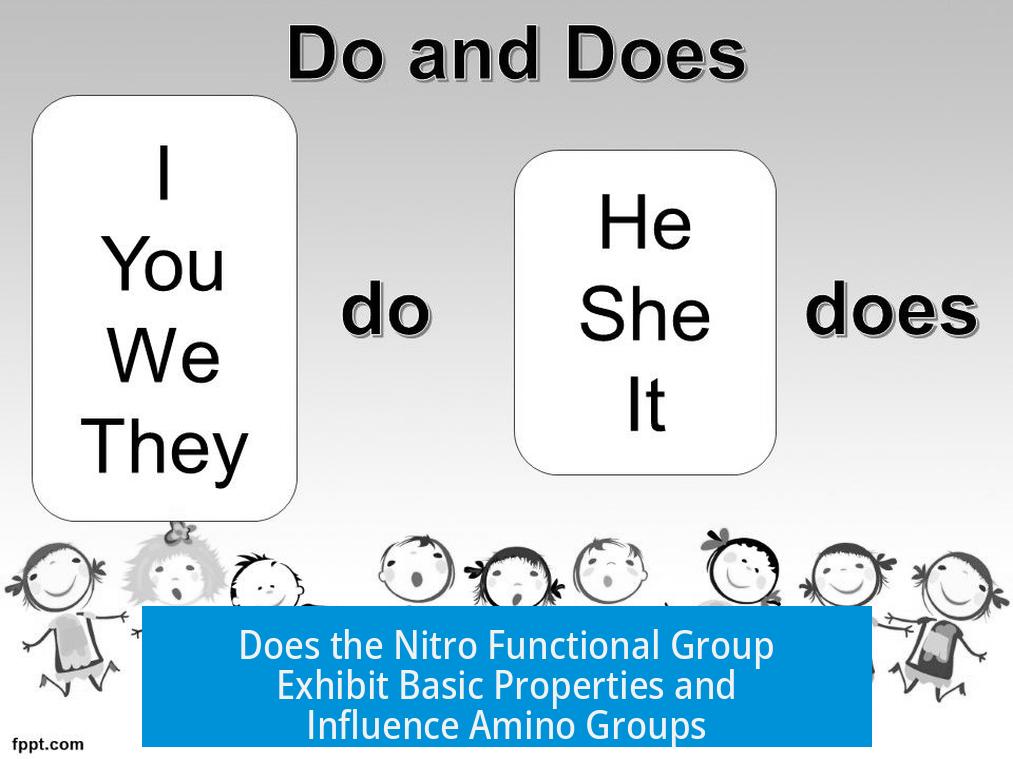Does the Nitro Functional Group Have Any Basic Properties?

The nitro functional group itself is not basic; it exhibits very weak basicity and typically does not accept protons under normal conditions. Instead, nitro groups tend to withdraw electron density, which influences the acidity and basicity of nearby groups rather than acting as a base themselves.
Basicity of the Nitro Group
The nitro group (–NO2) has oxygen atoms bearing a delocalized negative charge. This delocalization lowers the availability of lone pairs for protonation, making the nitro group non-basic in usual conditions.
- It is only very weakly basic and can be protonated by very strong acids but this is uncommon.
- When protonation occurs, it more often targets other groups, such as amines, rather than the nitro group itself.
Impact on Nearby Amino Groups
In molecules containing both amine and nitro groups, the amine dominates as the basic site. However, the electron-withdrawing nature of the nitro group reduces the basicity of the adjacent amino group.
- Inductive and mesomeric effects draw electron density away from the amino nitrogen.
- This electron withdrawal lowers the amino group’s ability to accept protons, weakening its basicity.
- The effect depends on the position of the nitro group; for example, if the nitro is meta (position 3), mesomeric effects vanish and the amino group retains higher basicity.
Examples and Comparative Basicity
Comparing compounds demonstrates the nitro group’s impact:
| Compound | Basicity Indicator | Observation |
|---|---|---|
| Aniline | Stronger base | No nitro group; amino group readily protonates. |
| Meta-nitroaniline | Weaker base (pKa of conjugate acid ≈ 2.47) | Nitro group reduces electron density; amino less basic. |
| Isolated nitro group | Very weakly basic | Rarely protonated; mainly electron withdrawing. |
Overall Acid-Base Character of Nitro Groups
The nitro group tends to increase acidic character in molecules. It draws electron density away, stabilizing conjugate bases and thus increasing acidity. This contrasts with basic groups like amines. Nitro groups themselves do not act as Lewis bases and do not significantly participate in proton acceptance.
For detailed protonation data on nitro groups, see the first paragraph after the abstract in the referenced article: https://pubs.acs.org/doi/abs/10.1021/ja00271a036
Key Takeaways
- The nitro functional group is not basic; it shows only very weak basicity under strong acidic conditions.
- Nitro groups withdraw electron density via inductive and resonance effects, reducing the basicity of adjacent amino groups.
- Protonation in nitro-containing compounds typically occurs at amine groups, not at nitro groups.
- Position of the nitro group affects its influence; meta substitution reduces resonance effects on amino groups.
- Nitro groups contribute acidic character to molecules rather than basic character.
Q1: Does the nitro group itself act as a base?
The nitro group is not basic. Its negative charge is spread over the oxygen atoms, making it very weak in accepting protons.
Q2: Can the nitro group be protonated under strong acidic conditions?
Protonation of the nitro group is rare and weak. Usually, if protonation occurs, it happens at an amine group instead.
Q3: How does the nitro group affect the basicity of nearby amino groups?
The nitro group pulls electron density from adjacent amino groups, weakening their basicity through inductive and mesomeric effects.
Q4: Does the position of the nitro group influence the basicity of amino groups?
Yes. If the nitro group is in the meta position, it does not exert mesomeric effects, so the amino group retains more basic character.
Q5: Overall, does the nitro group make compounds more acidic or basic?
Nitro groups tend to make compounds more acidic rather than basic. Nitroanilines are less basic than aniline due to these effects.





Leave a Comment